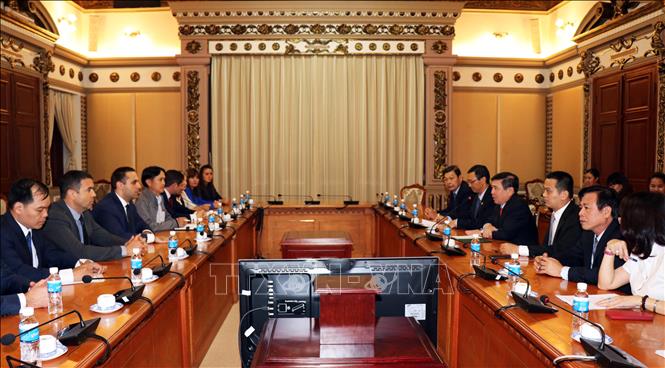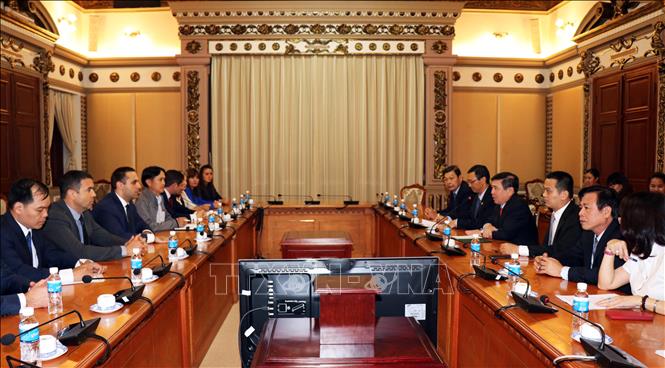
Hanoi capital city will include the two local heritage sites – the Thang Long imperial citadel and the Co Loa citadel relic – in the curriculum of local schools.
The city’s Education and
Training Department and the Thang Long-Hanoi Heritage Conservation Centre sign
the agreement on September 19 (Photo: VNA)
An agreement to this effect was signed between the city’s Education and
Training Department and the Thang Long-Hanoi Heritage Conservation Centre on
September 19.
Director of the Hanoi Education and Training Department Chu Xuan Dung said the
move aims at nurturing children’s interest in history in general and local
history in particular, and encouraging them to discover the heritage of the
city where they live.
Under the agreement, Hanoi schools will coordinate with the preservation board
to organize tours of the Thang Long imperial citadel during the school year as
an extra curriculum activity.
The Thang Long-Hanoi heritage conservation centre has designed various learning
programmes to suit different age groups and school level. Besides thematic
tours and exchanges with historians, the programmes arrange for students to try
their hands at making traditional handicraft such as making paper fans,
decorating pottery, printing folk paintings.
Tours of the Co Loa citadel relics also include folk games such as crossbow
shooting, a game associated with the legend about the citadel, or tug of
war.
Director of the centre Tran Viet Anh said the sides will make assessment of the
teaching every year based on feedback from teachers and students.
With the goal of promoting the heritage among the community, the Thang
Long-Hanoi conservation centre has worked with the Hanoi UNESCO Office, the
Vietnamese Association of Historical Sciences and experts to develop
educational activities target students.
Last year, more than 3,900 students in Hanoi participated in educational
activities at the Thang Long imperial citadel, and more than 18,000 children
attended side activities such as Lunar New Year and Mid-Autumn Festivals held
at the site.
The Thang Long Imperial Citadel was recognised as a UNESCO World Heritage Site
in 2010. At the citadel, many artefacts and items dating back to between the
6th and 20th centuries were excavated in 2004, including foundations of old
palaces, ancient roads, ponds and wells. On top of these discoveries,
archaeologists also found bronze coins, ceramics and pottery from many places
in Asia, all of which demonstrate a close trading relationship in the
area.
Co Loa Citadel was built during the end of the Hong Bang Dynasty (about 257
BC), about 20km to the north of today’s Hanoi.
It is a place of worship for King An Duong Vuong and Princess My Chau, who are
mentioned in the legends that have been passed down many generations.
According to folklore, An Duong Vuong founded the ancient Vietnamese state of
Au Lac and chose Co Loa as the capital city.-
Source: VNA
Appreciating the abundant potential and strengths of his hometown for tourism development, Ha Cong Hung, Deputy Secretary of the youth union of Mai Chau district’s Mai Hich commune, embarked on producing smoked meat with a desire to introduce his homeland's specialty to domestic and international tourists.
Hoa Binh farmers are investing big in their chilli pepper cultivation areas after the first batch of 7.5 tonnes of pickled chilli peppers was shipped to the Republic of Korea (RoK) by Tien Ngan Trade and Investment Co., Ltd last month.
Recognising the role and importance of developing the collective economy, the northern province of Hoa Binh has promptly issued support policies to propel the development of the economy, making important contributions to local socio-economic development.
Prime Minister Pham Minh Chinh attended a groundbreaking ceremony for an electronic printed circuit board (PCB) factory at Da River Left Bank Industrial Park in Hoa Binh province on April 13. The electronic PCB factory is invested by Japan's Meiko Group at a total cost of 200 million USD.
In the first quarter of 2024, the credit institutions in the province have actively deployed the legal documents of the State and the State Bank relating to currency, credit and interest rates. At the same time, they have promoted the capital mobilization, focusing on the solutions to expand the credit investment along with strengthening the credit quality management, lending to priority programs to promptly meet the capital needs for export - business and consumer demand during Tet in 2024.
Outside the key economic region of Hoa Binh, yet Lac Son district has utilised its potential and strengths regarding labour, land, and transportation connectivity to attract investment to the locality, contributing to promoting socio-economic development.



